Easy fish curry with fresh flavors of coconut, tamarind and pearl onions! Made with just 7 main ingredients, this Kerala fish curry with coconut is the perfect recipe for a quick and easy dinner.

FEATURED COMMENT
The curry turned out awesome. This is the first non-vegetarian dish I have ever prepared that doesn’t have ginger or garlic in it and it didn’t really make any difference. Thanks for sharing this recipe. Looking forward for more recipes…
DIALINE
Affiliate disclosure: This post contains affiliate links, which means I may receive a small commission, at no cost to you, if you make a purchase through a link.
Reasons You’ll Love This Recipe
Do you get intimidated by the thought of cooking up a curry? Or by the smell of fish?
This easy Kerala fish curry recipe shows you how to make fish curry that doesn’t smell “fishy”!
TOO GOOD TO BE TRUE? I understand.
We usually think we need a ton of spices to make even the simplest fish curry. That was until I learned this recipe from my mom.
Like most of my seafood recipes, this Kerala-style fish curry is one of the best fish recipes for beginners. Reason?
- It uses very few simple ingredients you might already have.
- This nadan fish curry gets done in less than 30 minutes.
- It is as healthy as a curry can be. There’s no need to fry or saute. We use just 2 teaspoons of oil at the end of cooking.
- Use any fish for this Kerala meen curry (similar to Mangalore fish curry). Even bland fish will do since there are a lot of fresh flavors going on in the gravy.
- Even if the fish has a strong odour, it is compensated by lemon and tamarind.
- Tamarind can also help preserve the curry, so it lasts long.
Quick housekeeping tip: If your house reeks of bad odour for some reason, try doing this before you reach out for an air freshener: Boil tamarind (or its pulp) with a cup of water and simmer for 15 minutes. Leave the container open for a while. The unpleasant smell will be gone!
This fish curry is yet another in the looong list of my mom’s easy Kerala curry recipes like Kerala chicken curry, chicken varutharacha curry, nadan egg roast, parippu curry, and sprouted mung bean curry.
This is how you make it:
Video
Ingredients
(You can find the exact measurements and instructions in the printable recipe card at the end of this page.)
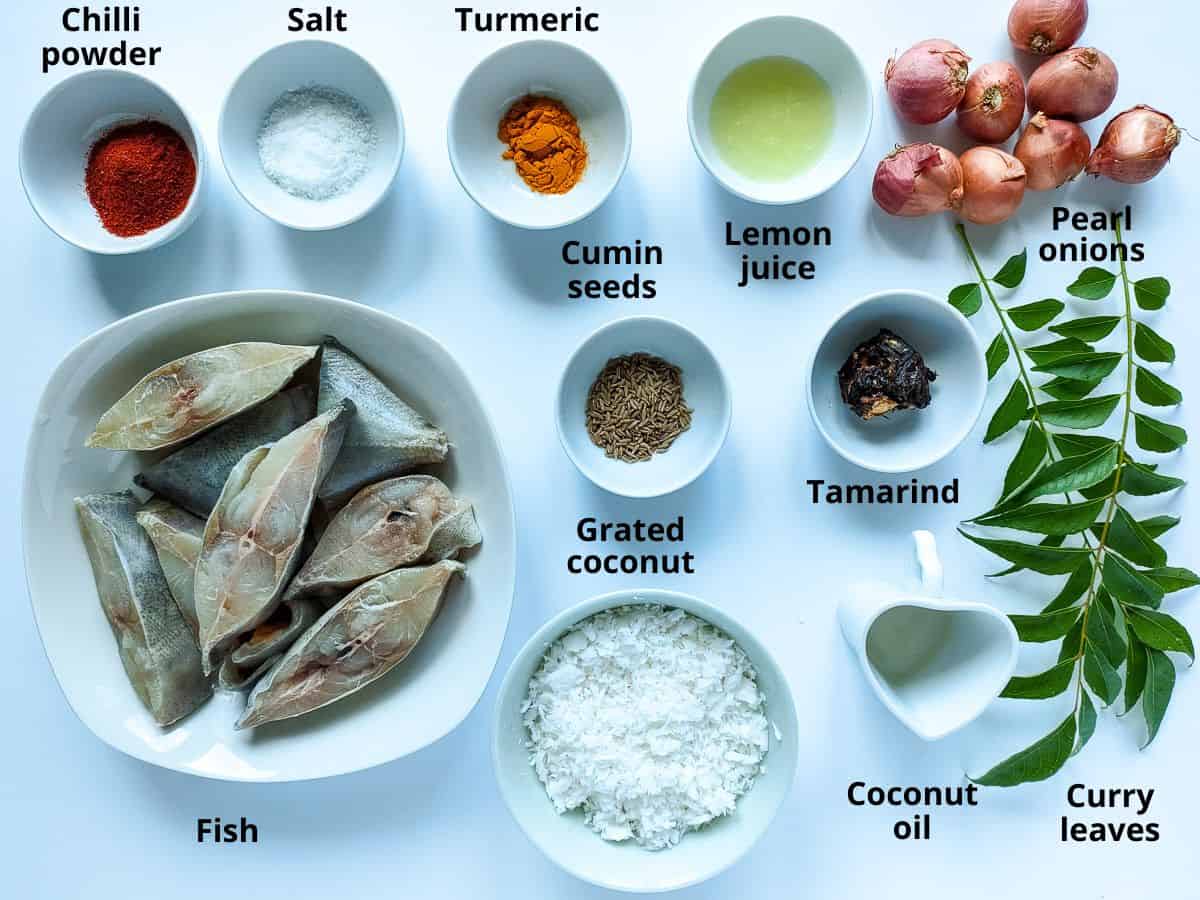
- Fish: I’ve used pomfret here. It is also called butterfish or pompano. (Which I used for the popular tandoori pomfret.) Any fish like sardine or mackerel can be used. (I usually reserve mackerel for recipes like fish cakes and baked fish which require more meaty fish.)
- Coconut: For this recipe, like egg kurma, grated coconut is a must-have ingredient.
- Tamarind: A common ingredient in South Indian cooking, it is easily available at any Indian store. (I haven’t used tamarind pulp, but I’m not sure if it has the same flavor. If you used it to make this curry, please let me know in the comments section.)
- Onions: Pearl onions add to the subtle Kerala flavors in addition to coconut (as in Kerala chicken curry).
- Spices: Chilli powder, turmeric powder and cumin seeds are all you need for this curry.
How To Make Kerala Fish Curry With Coconut: Step by step
Soak Tamarind
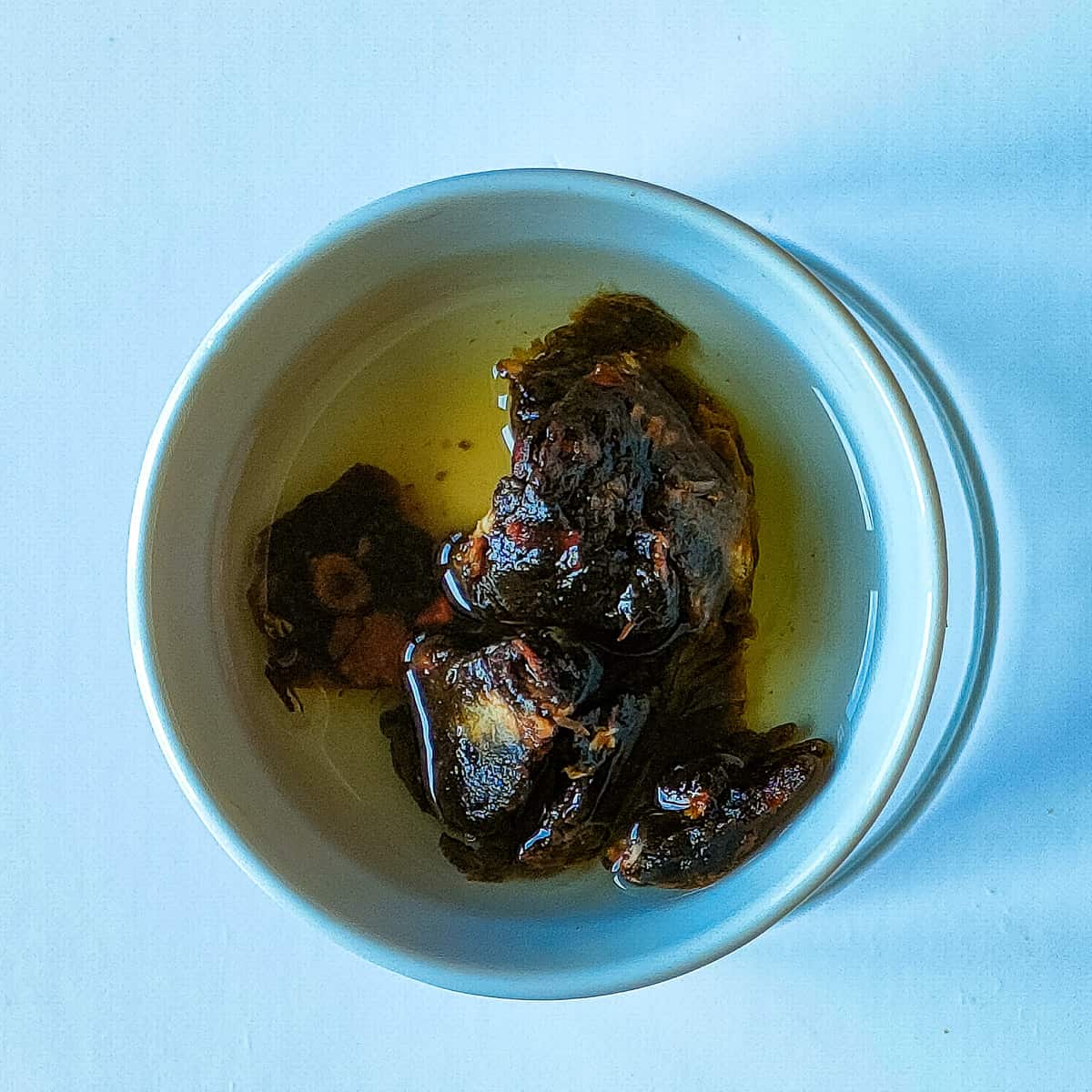
Soak tamarind in ¼ cup of hot water. This will help soften the tamarind for blending with coconut later on.
Season The Fish
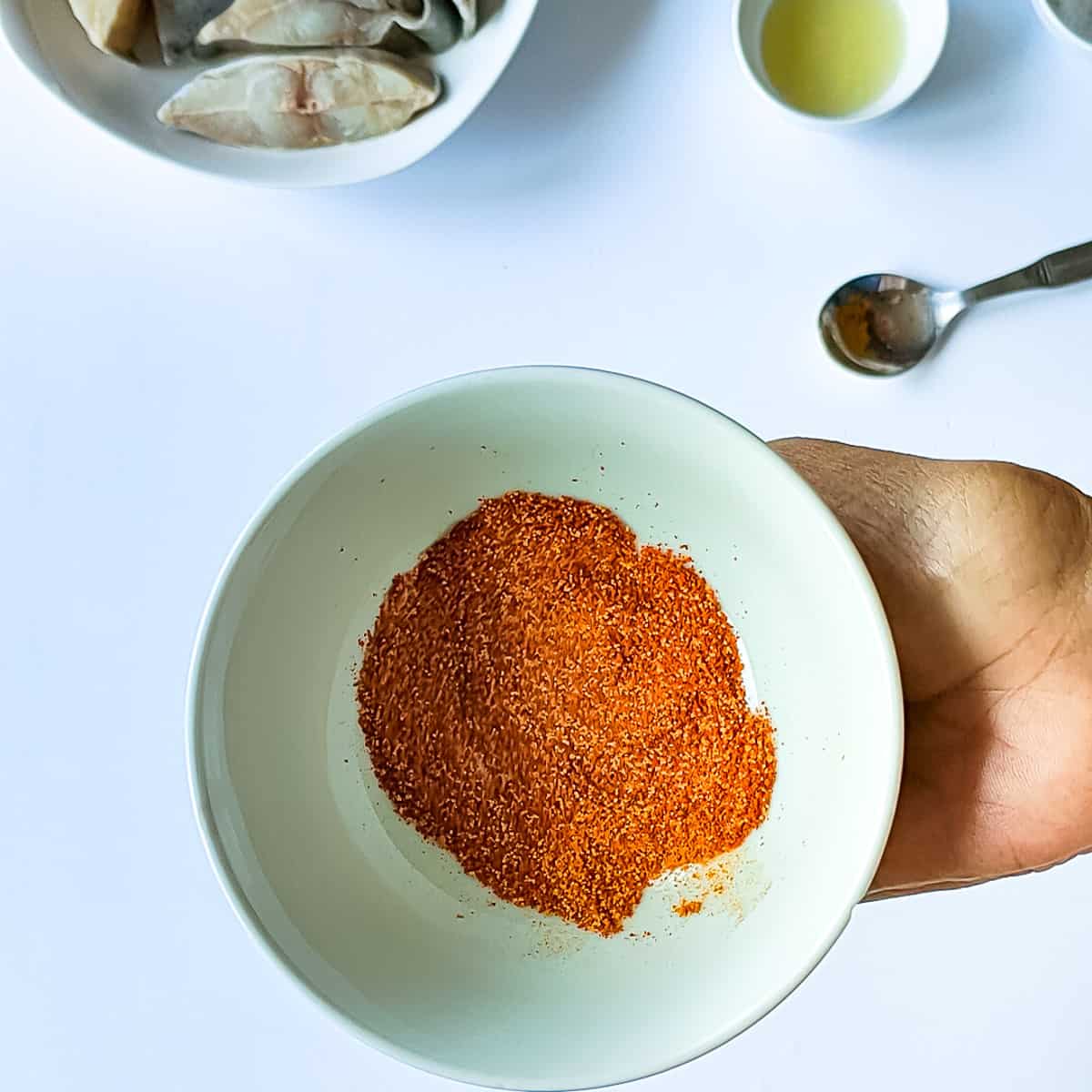
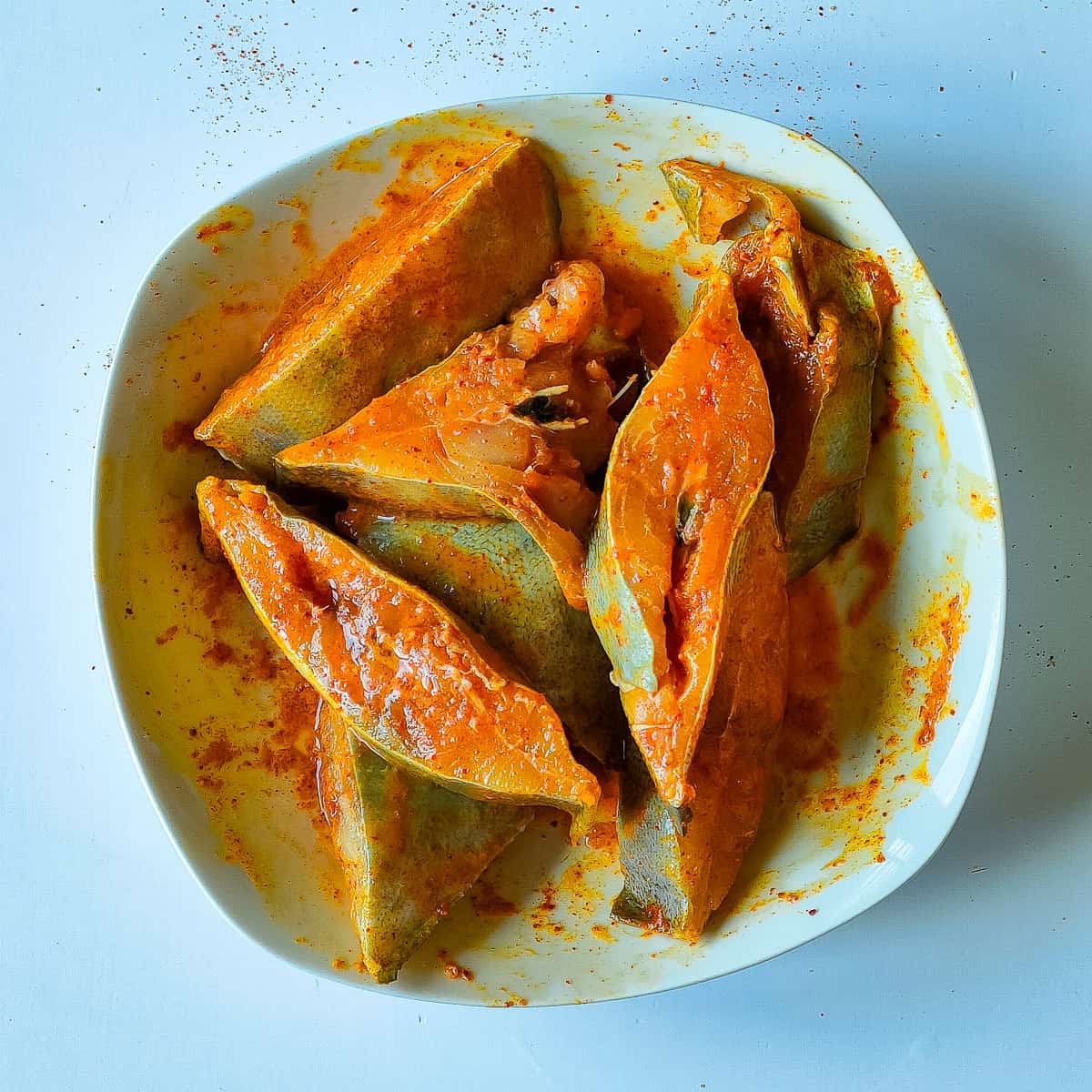
As in my masala prawns, seasoning fish for at least 10 minutes makes all the difference to this fish recipe. Mix chilli powder, turmeric powder and salt in a small bowl and season the fish with it. Add lemon juice to the fish and mix well.
Make Coconut Paste
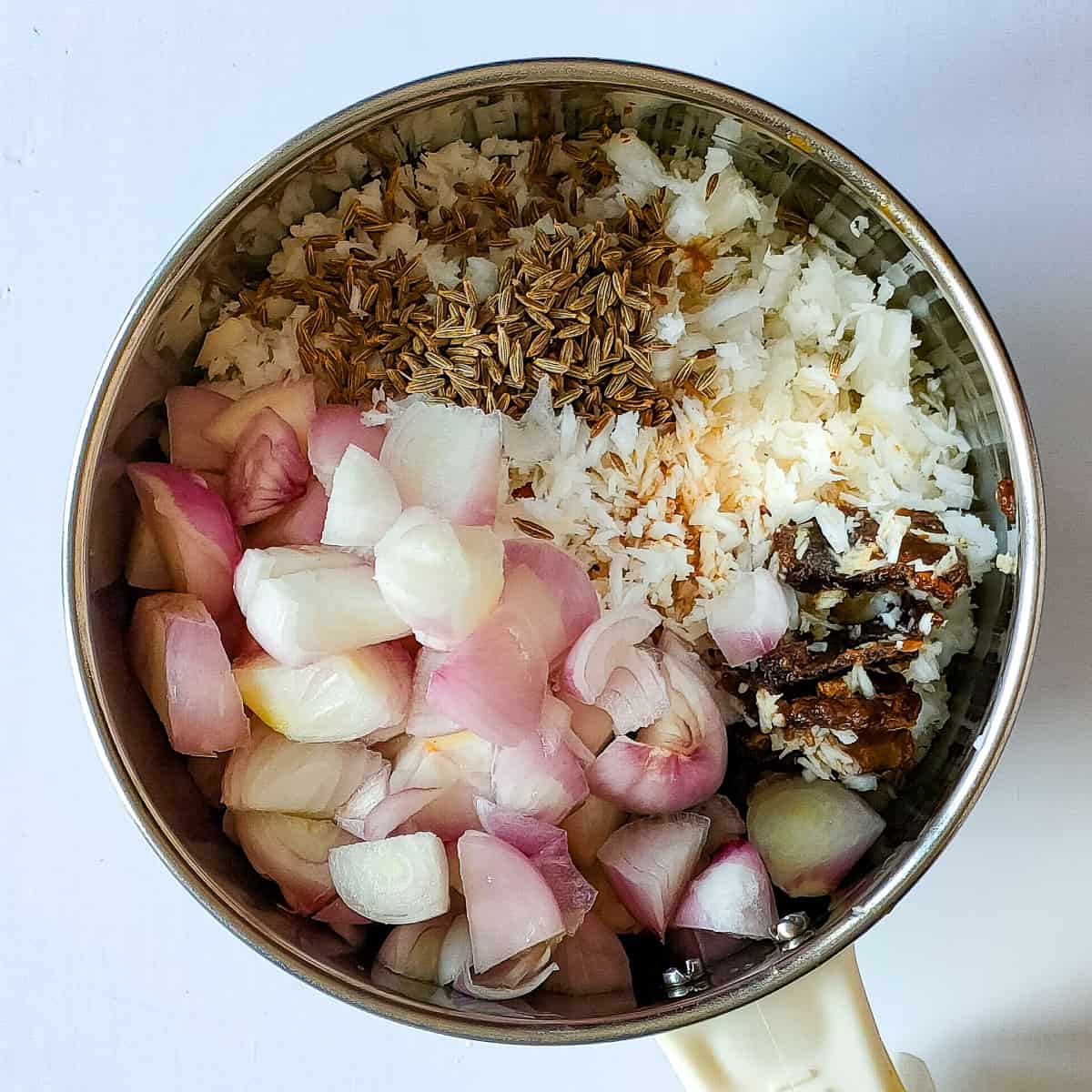
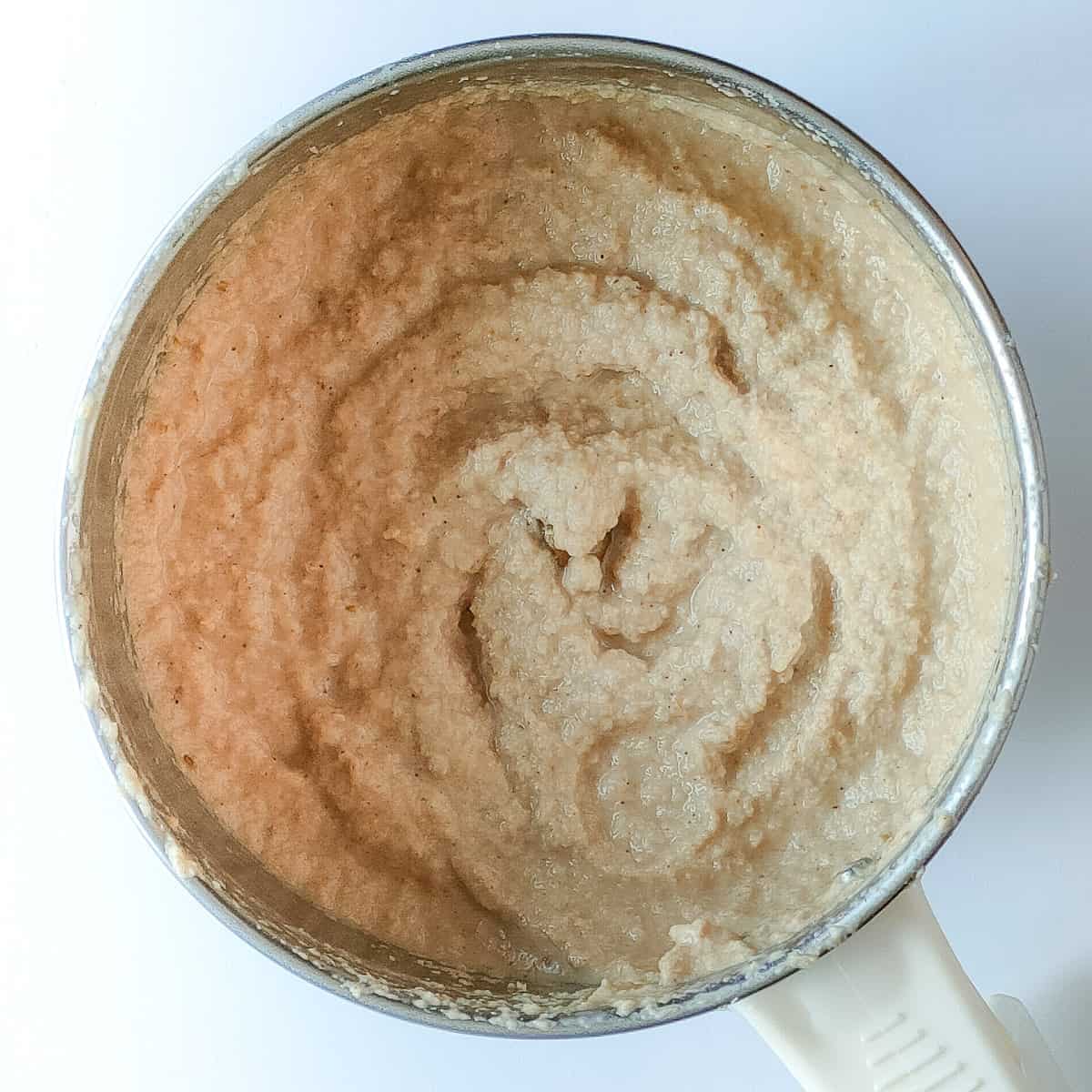
Roughly chop pearl onions. Place them in a blender jar with grated coconut, cumin seeds, and soaked tamarind along with the water.
Blend into a smooth paste.
Make Nadan Fish Curry
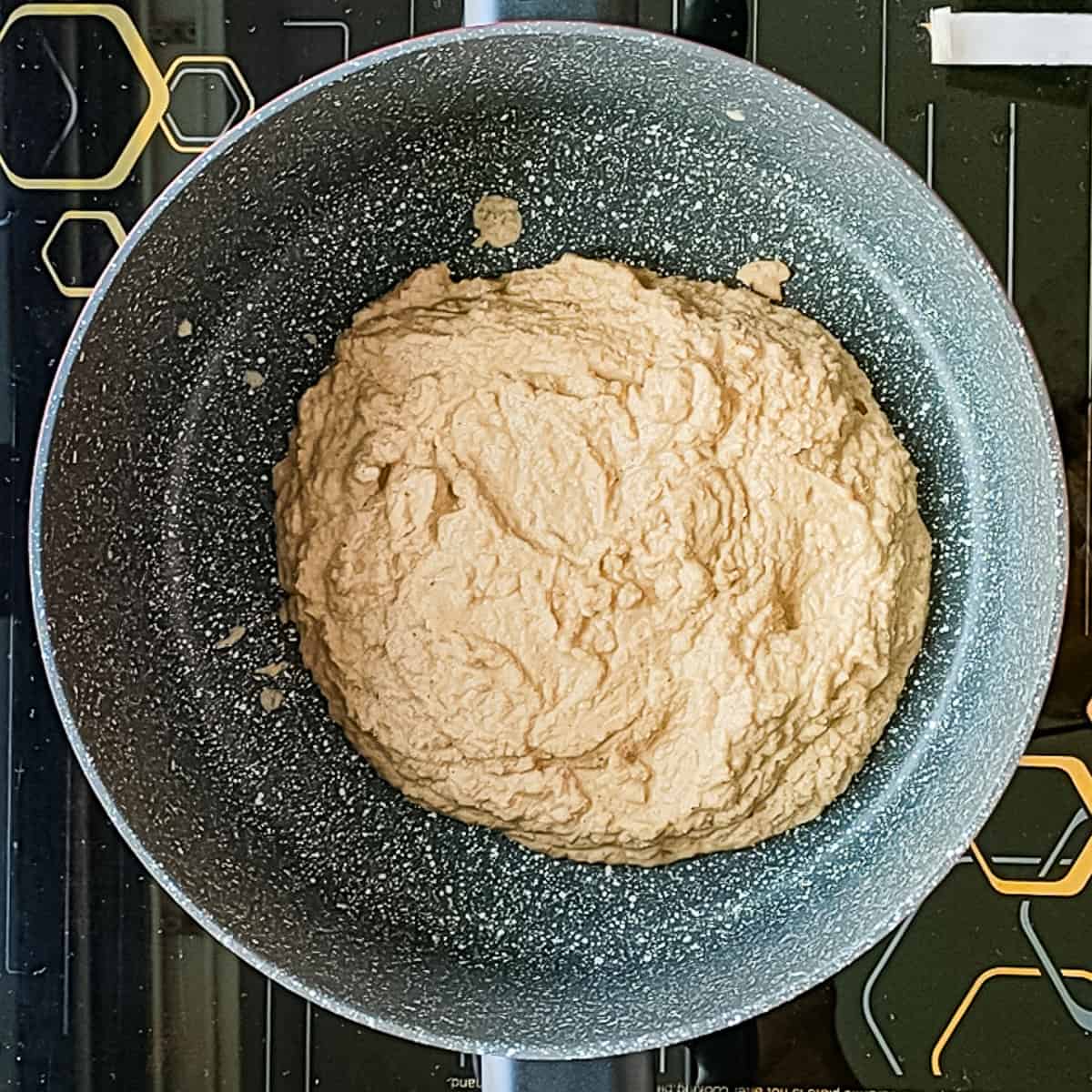
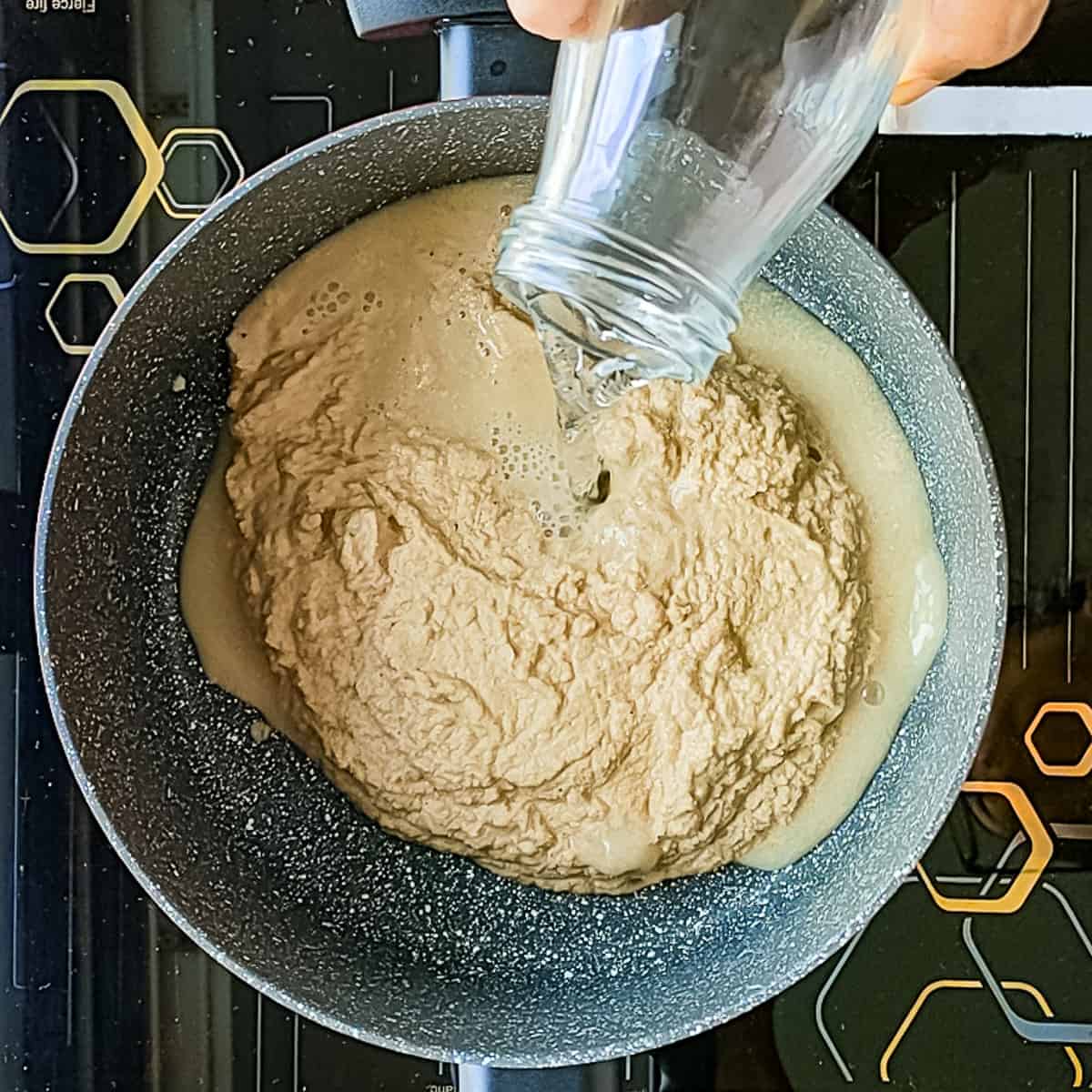
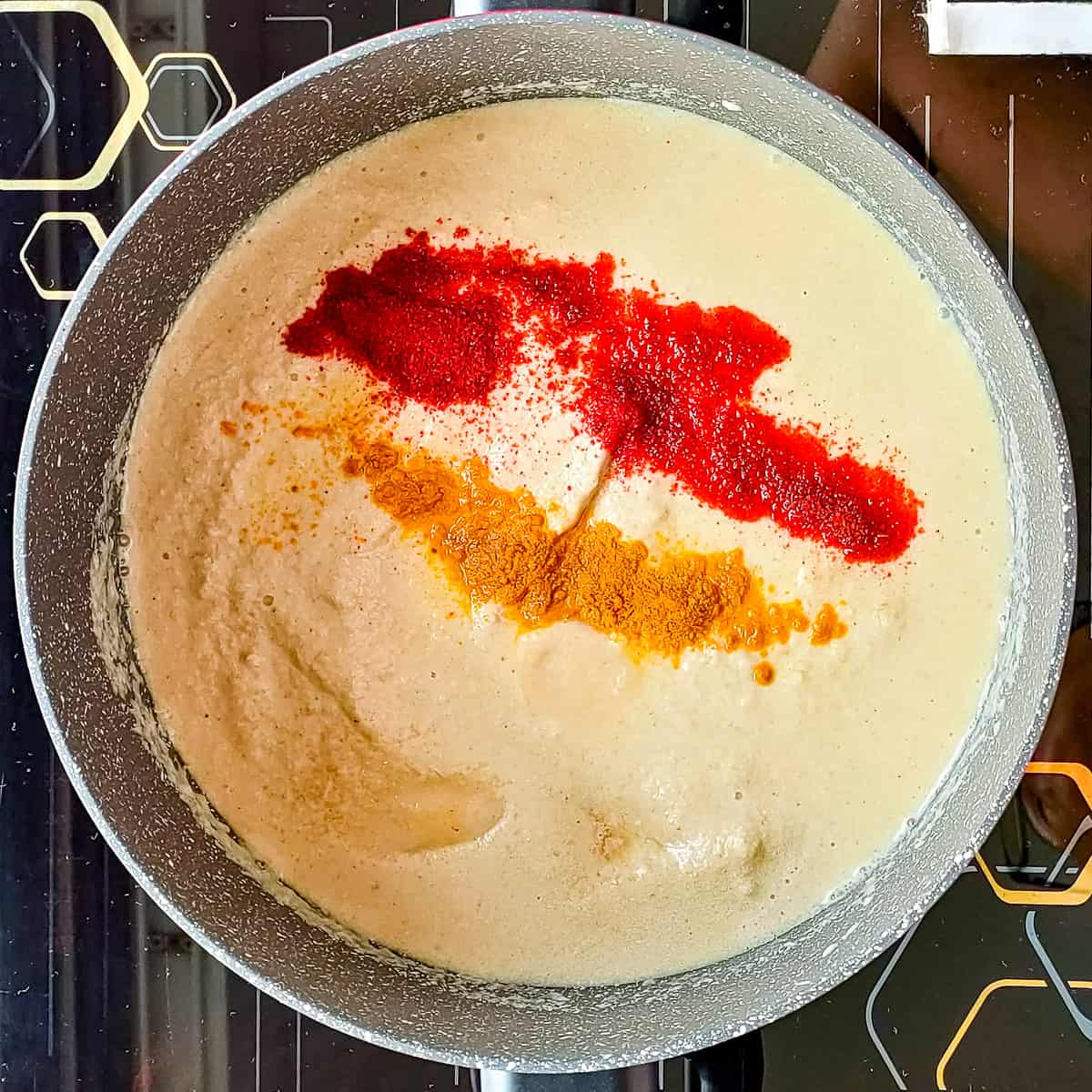
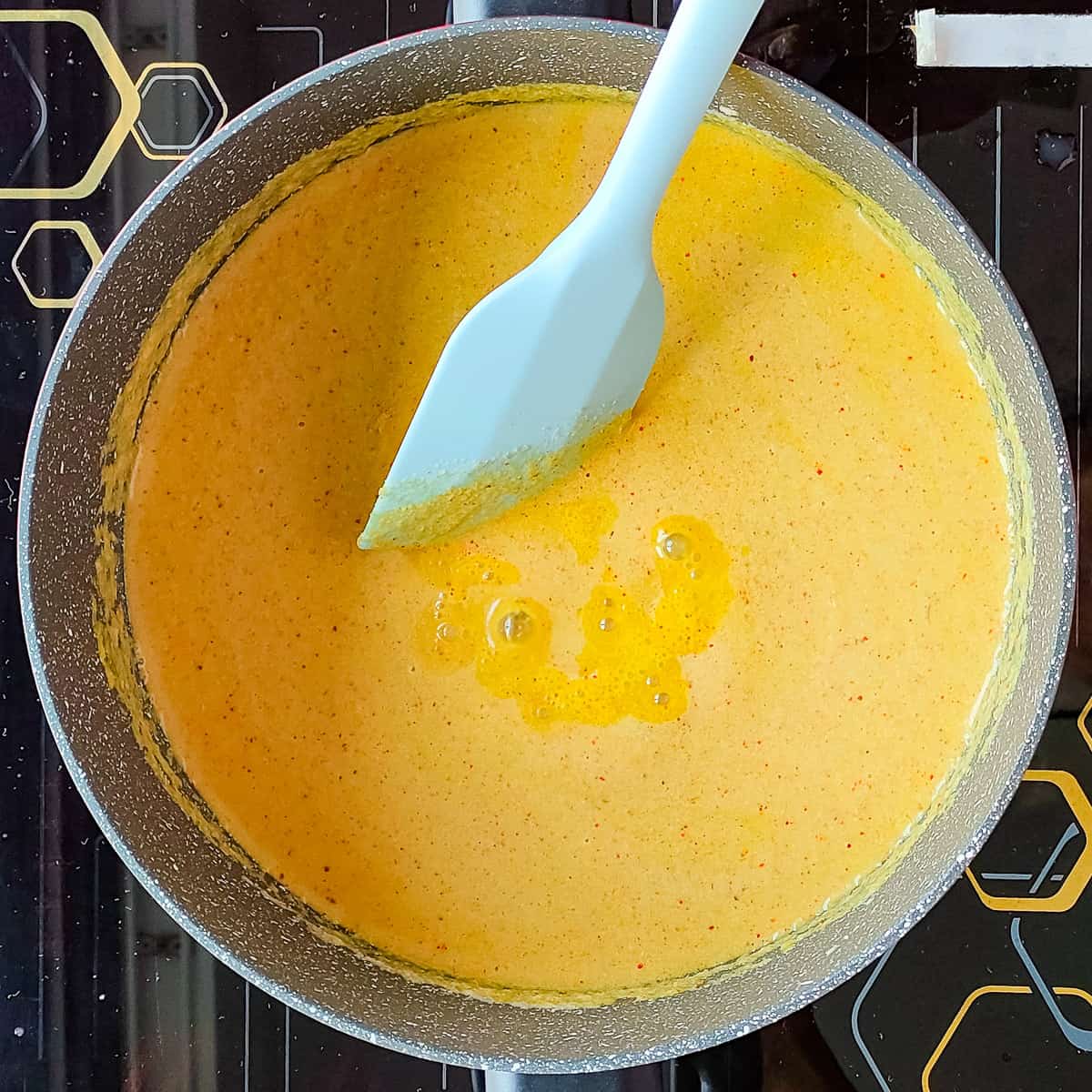
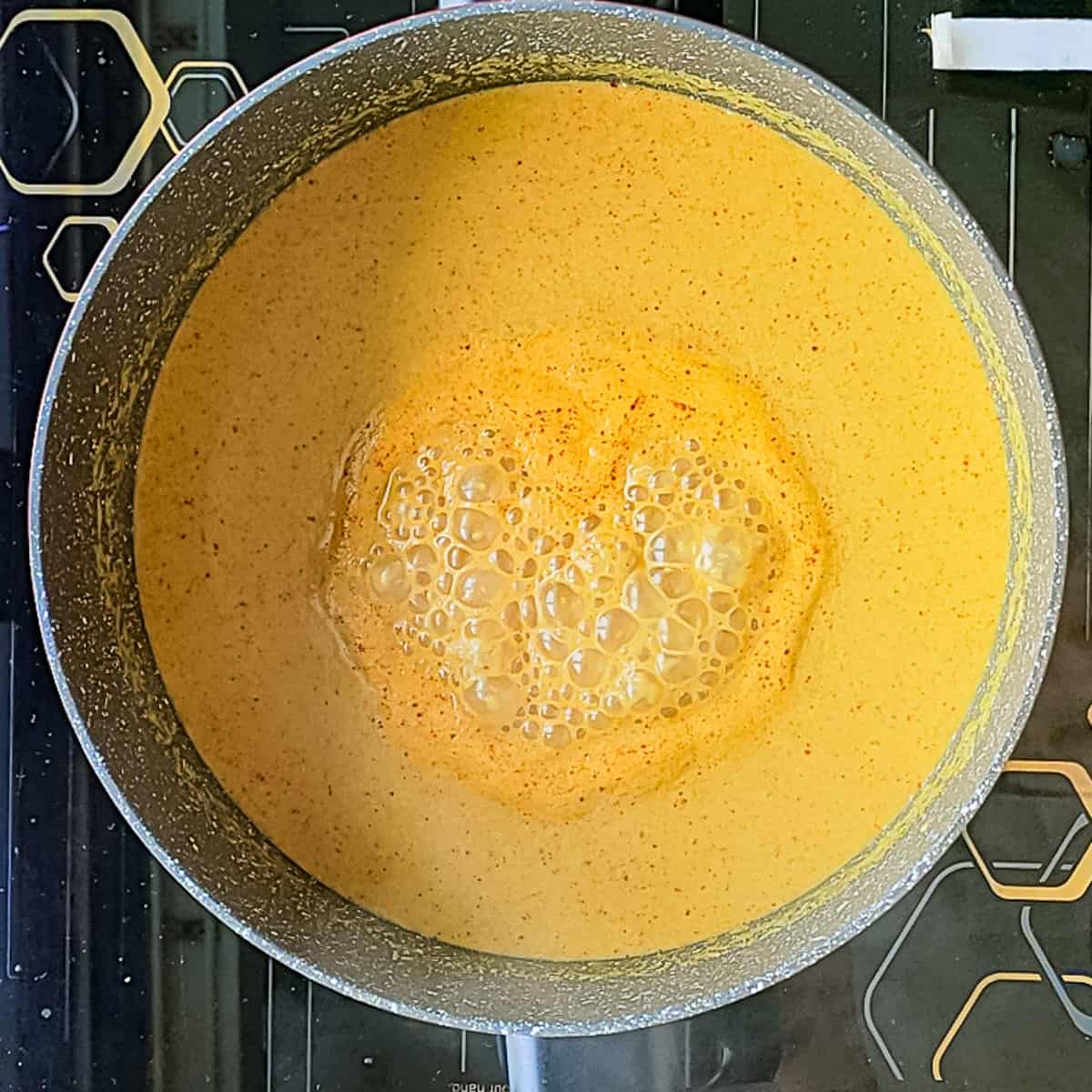

- Transfer the blended coconut onion paste to a deep pot or kadai.
- Add 1 cup of water and mix.
- Add the spices: chilli powder, turmeric and salt.
- Mix and bring it to a boil.
- Reduce the flame and add the seasoned fish pieces.
- Simmer for 5 to 10 minutes, until the fish is cooked through.
Finish up
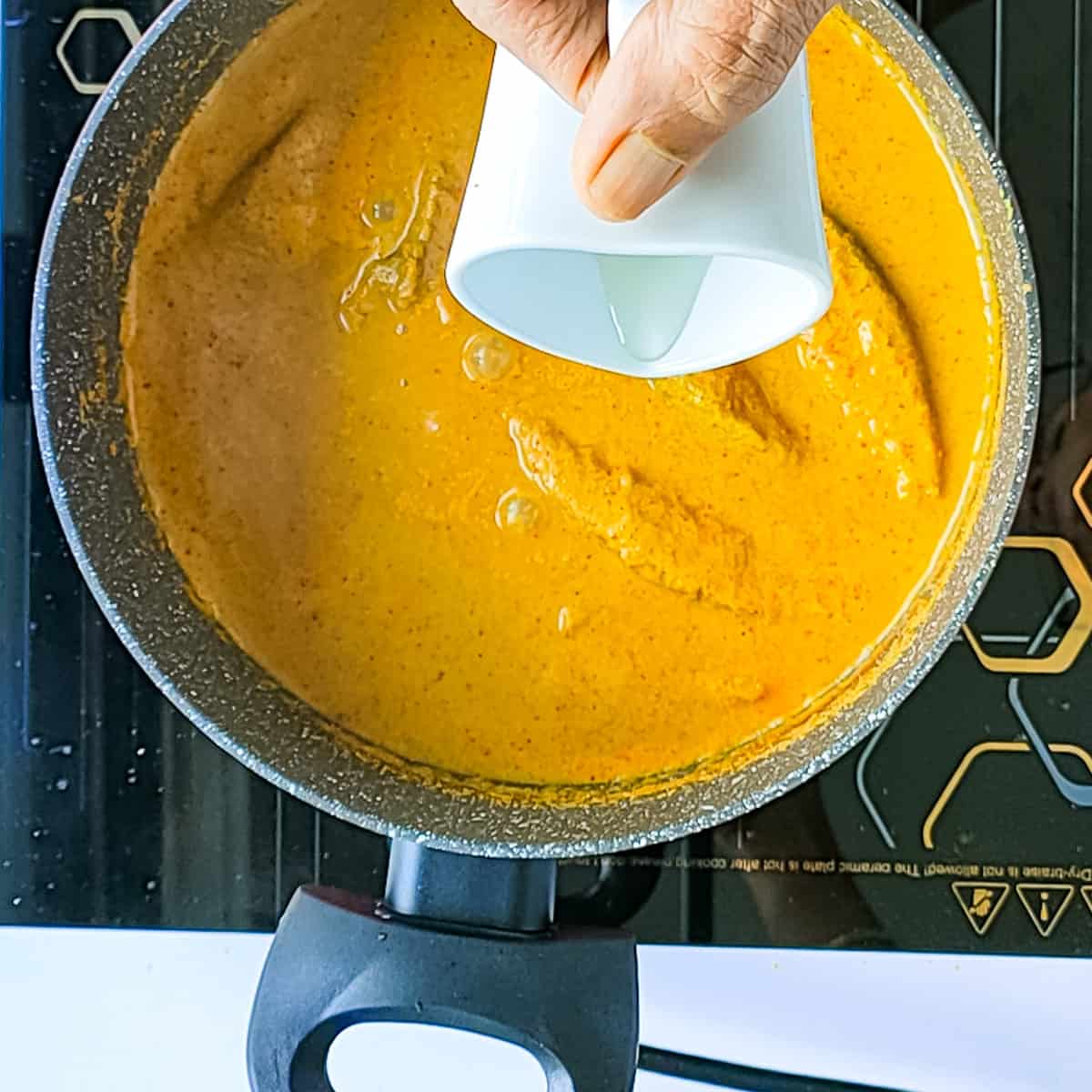

Drizzle coconut oil on the curry and turn off the flame immediately.
Garnish with torn curry leaves. Serve with steamed rice or dosa.
For those low-carb days, pair this Kerala meen curry with coconut cauliflower rice. Tastes amazing!
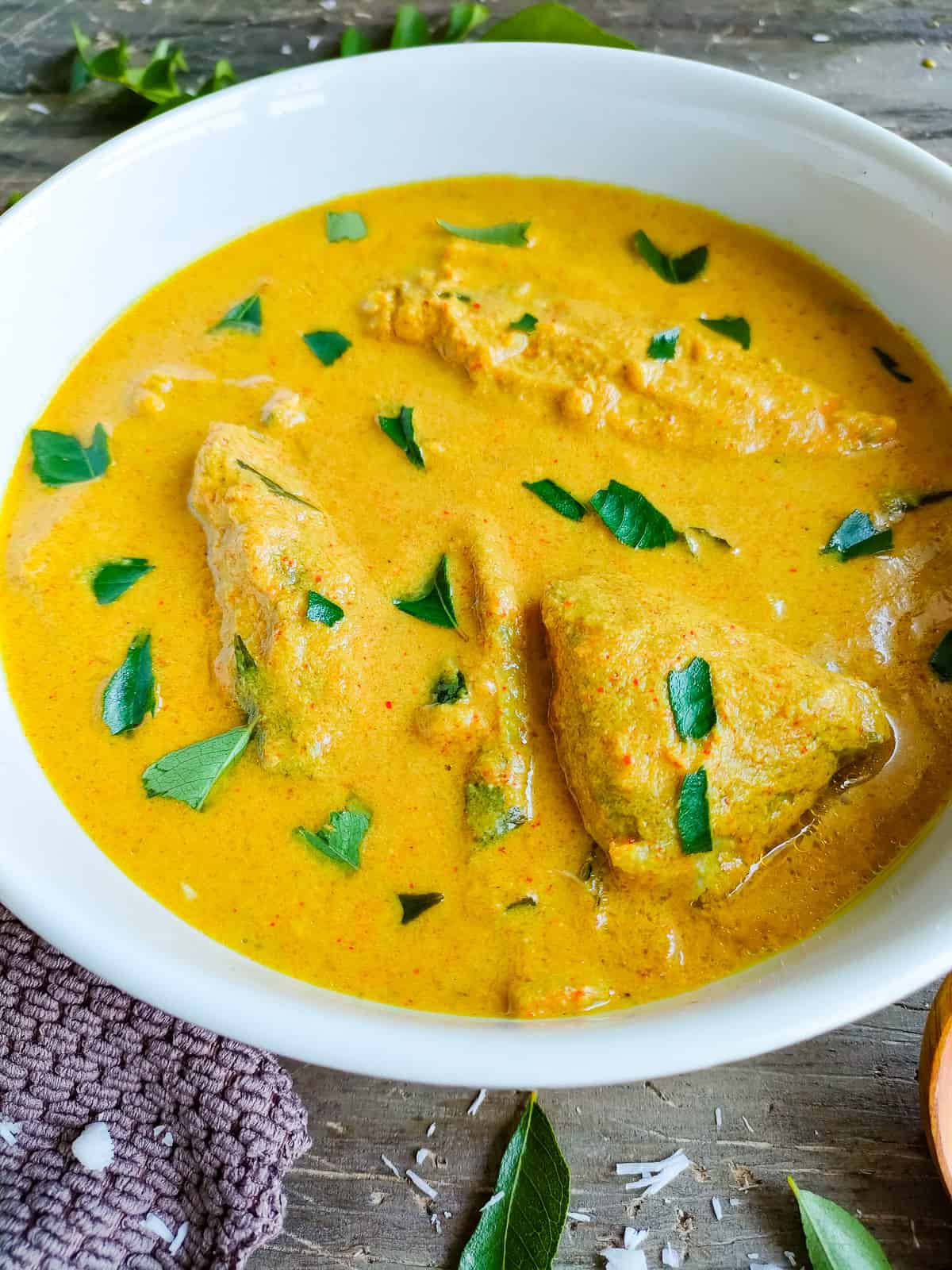
Tips To Make The Best Nadan Fish Curry, Kerala-style
- Fresh ingredients: In this recipe, we do not saute or fry the ingredients. So ensure that you use fresh, good-quality ingredients to make the most of fresh flavors.
- Coconut oil: Turn off the flame as soon as you add coconut oil. You should ensure that you get the fresh flavor of coconut oil for an authentic Kerala-style curry experience. Use extra virgin coconut oil for maximum flavor.
- Spice: Sometimes I like to add one or two dried red chilies for a spicier curry.
- Chili powder: If you want a reddish tint to your Kerala fish curry, try replacing the chili powder with double the quantity of Kashmiri red chili powder. It gives flavor and color to the curry without the heat.
- Cooking time: Adjust the simmering time according to the size of the fish pieces. If you’re using bigger pieces of fish like Mackerel, increase the cooking time by 5 to 10 minutes. The fish should be opaque throughout. Check for doneness by flaking the fish in the middle.
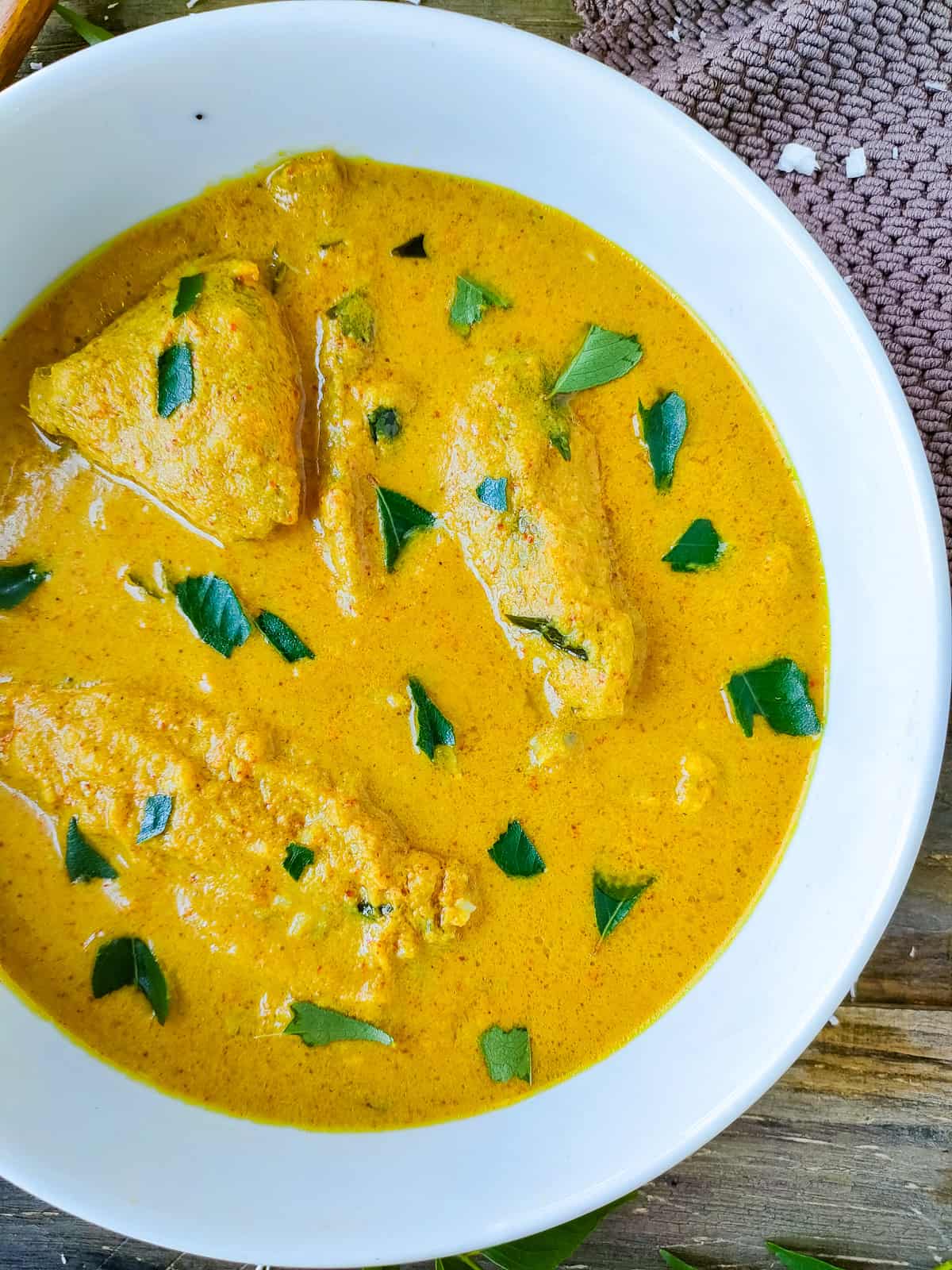
Recommended tools to make this recipe
- Blender: Effortlessly whips up the coconut paste.
- Pot: These non-stick pots are perfect to make curries and are easy to clean. The deep pot ensures there is no splashing when the curry is boiling.
- Knife set: Razor-sharp blades and ergonomic handles make it very easy to chop and dice.
- Prep bowls: These prep bowls with lids come in handy when you want to mix spices or store them. They can also be stacked, saving space in the kitchen.
- Spatula: You need the best ones if you want to protect your non-stick cookware.
Health Benefits of Tamarind
- Tamarind is a rich source of antioxidants and can enhance the efficacy of the body’s natural immune defenses.
- Tamarind seed extract has antioxidant enzyme induction properties that may reduce the risk of cancer.
- Being rich in polyphenols and flavonoids, tamarind has the effect of reducing diastolic blood pressure, thus improving heart health and cholesterol.
- Tamarind extract contains antioxidants called procyanidins, that counter free radical damage to the liver.
- It provides natural antimicrobial benefits against pathogenic microorganisms.
- The anti-inflammatory effect of tamarind seed extract has been shown to improve blood sugar regulation in those with diabetes.
Health Benefits of Coconut
- Coconut has anti thrombotic, anti-carcinogenic and anti-ageing effects on the body.
- A 200 grams of coconut serving daily can lead to significant reduction in both BMI and waist circumference in just 12 weeks.
- It controls diabetes by positively affecting the hormones for blood sugar control.
- Coconut nutrition is excellent for the immunity system. It is antiviral, antifungal, antibacterial, and anti-parasitic.
- Eating coconut regularly supports the development of healthy bones and teeth.
- It is high in dietary fibre and provides a whopping 61% of fibre.
- Coconut helps to increase energy by burning fat.
- It helps to improve blood cholesterol levels in the body and lowers the risk of heart disease.
- Coconut nutrition has also proven to have anti-cancer properties.
- Eating coconut hydrates the skin and makes it youthful and supple.
- Eating coconut regularly boosts oxygen in the skin and promotes blood circulation.
Printable Curry Paste Recipe
Grab a printable copy of the curry paste that helps home cooks like you cook different curries in 30 minutes or less:
More Curries
Easy One Pot Brussels Sprouts Curry (Indian Spiced)
Simple Egg Omelet Curry with Roasted Coconut Masala
Easy Chicken Rogan Josh
Quick and Easy Kadai Vegetable
★★★★★Did you try this recipe? Please give a star rating in the comments below ★★★★★
HUNGRY FOR MORE? Join over 1000 home cooks like you who subscribe to my weekly newsletter to get all the latest recipes right in your inbox. Or follow me on your favorite social media: Facebook, Pinterest, Instagram, and YouTube. Thank you and happy cooking!

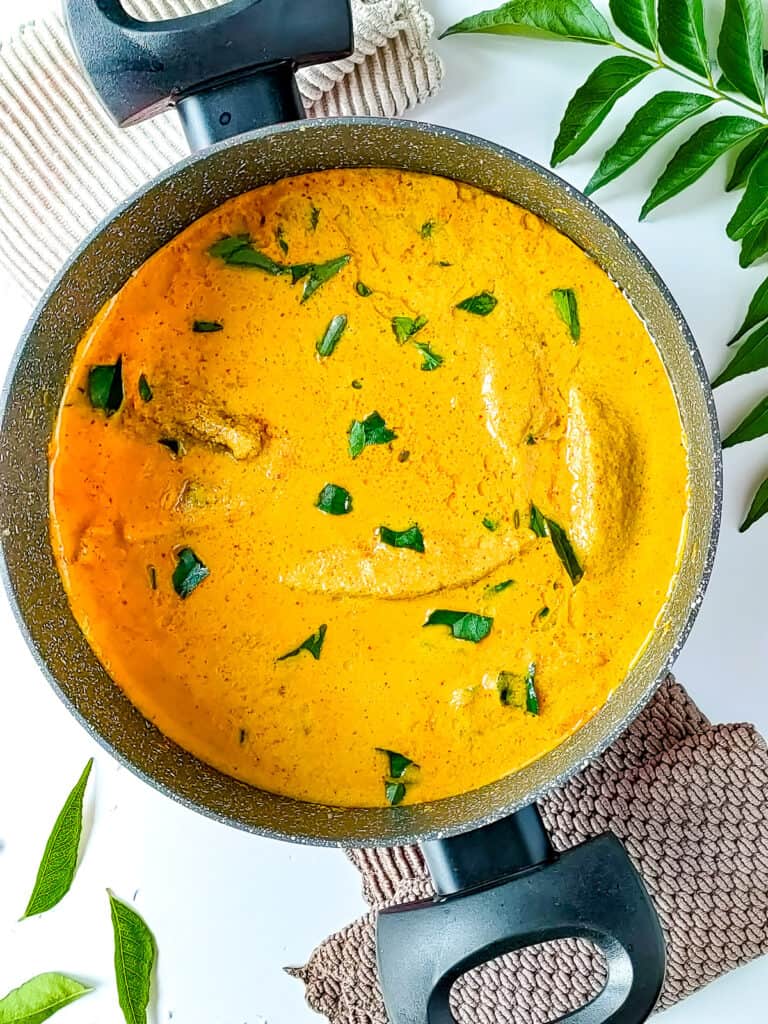
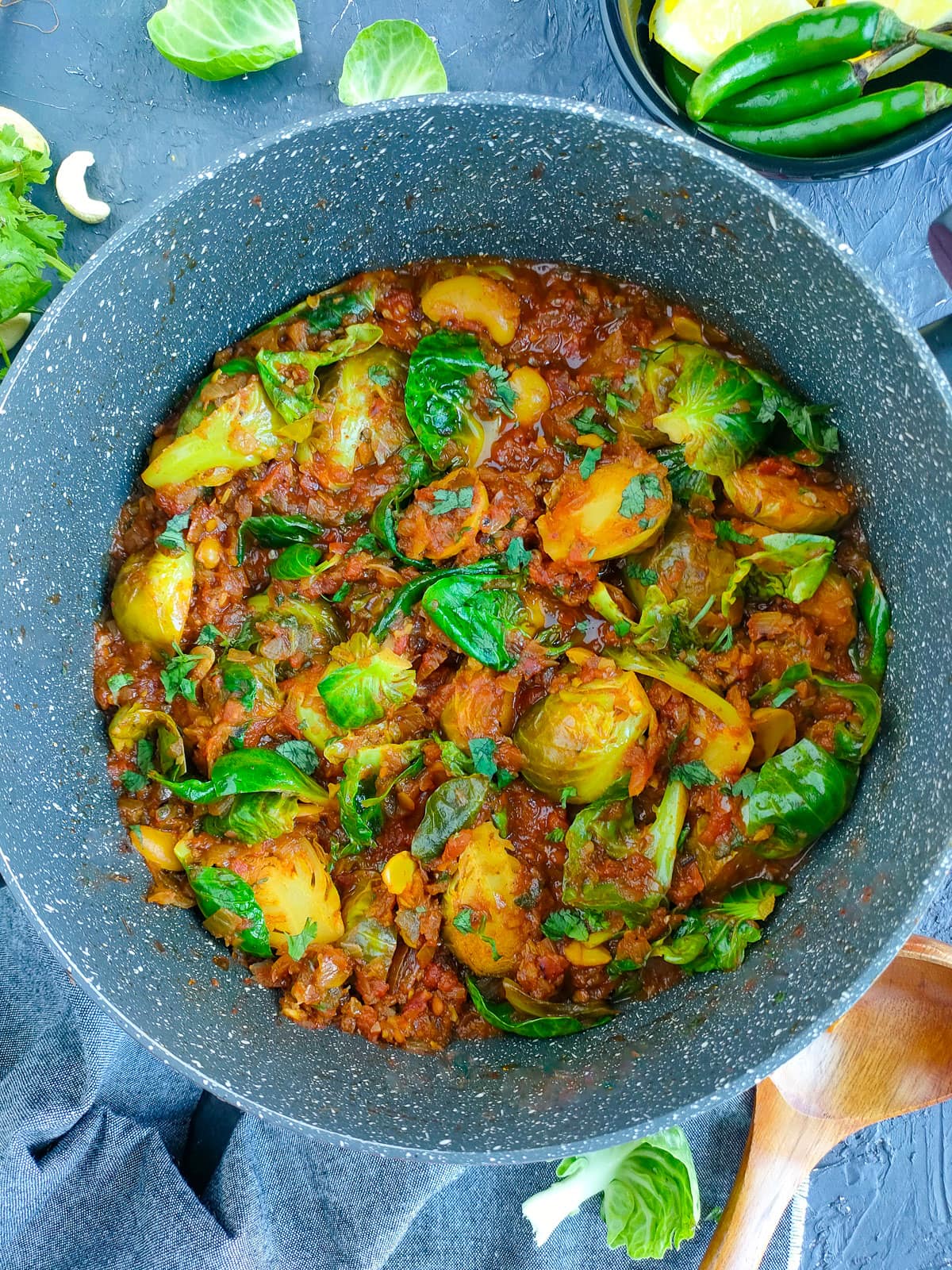
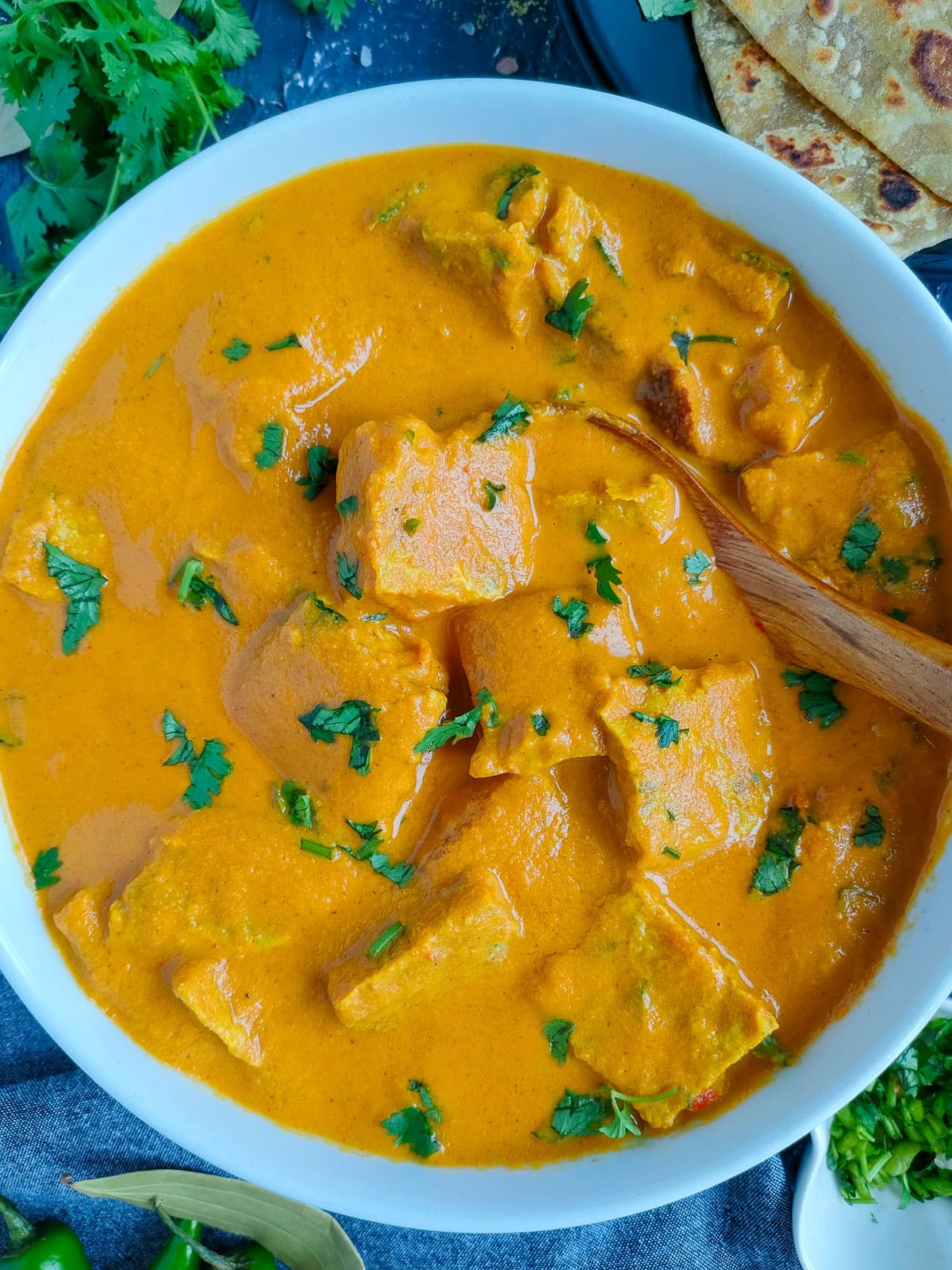
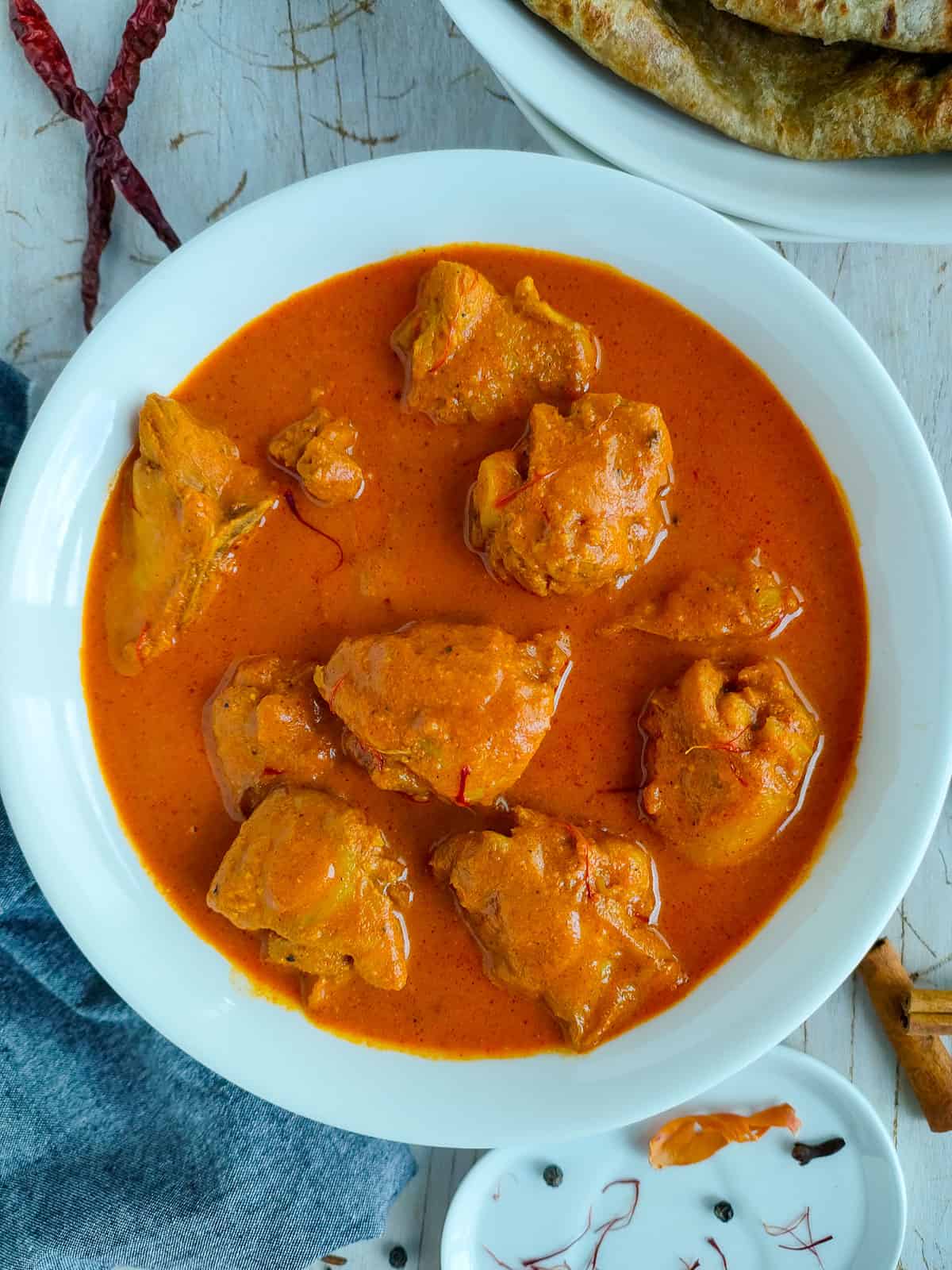
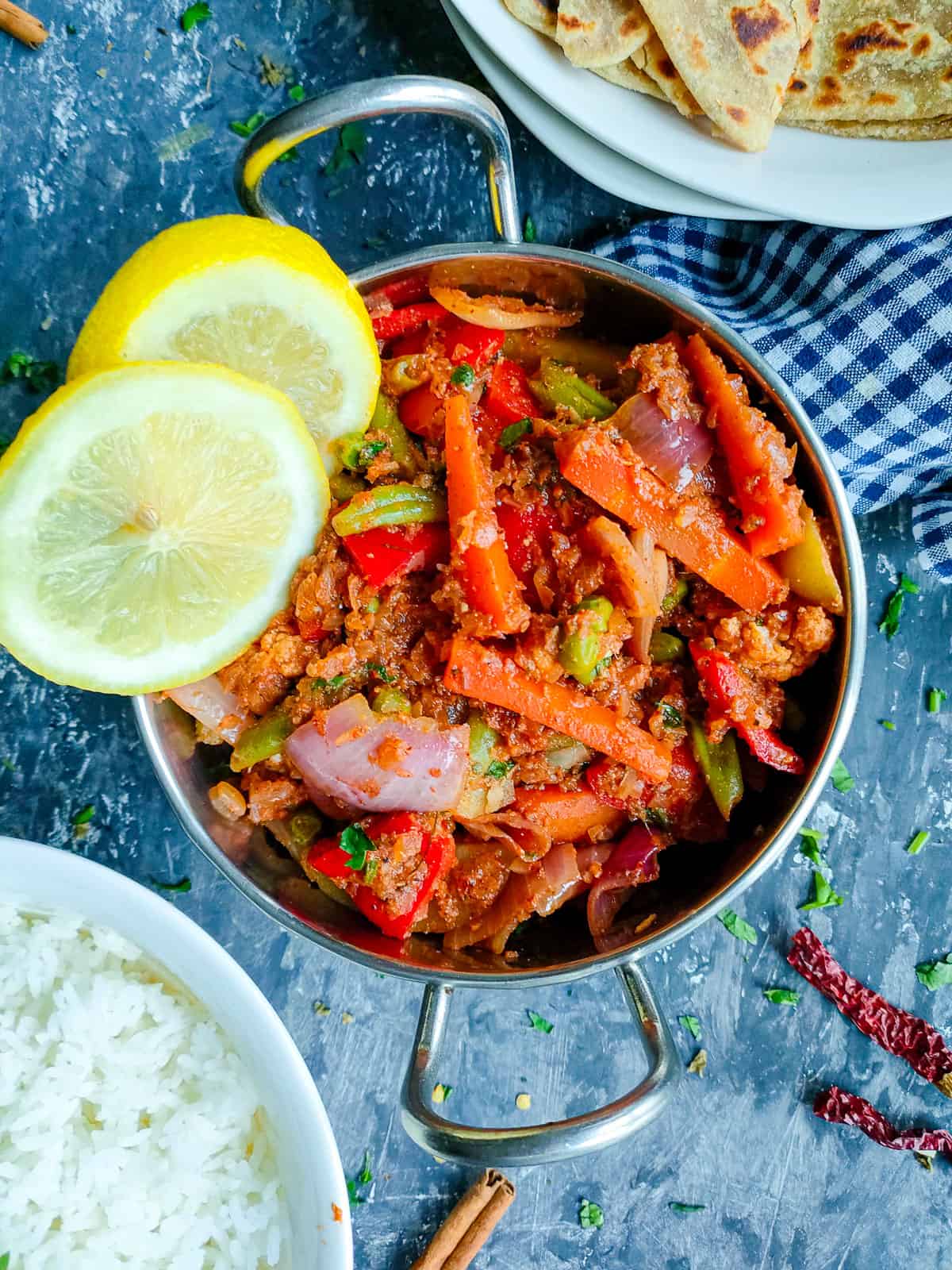
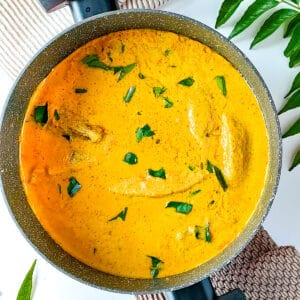

OMFG !!! I did it!!! It was da bomb.. followed the recipe to the point.. had them with dosa..will keep making it. It was very easy and super tasty
Thank you, Ash! You made my day!!
The curry turned out awesome. This is the first non-vegetarian dish I have ever prepared that doesn’t have ginger or garlic in it and it didn’t really make any difference. I didn’t have the pearl onions so managed with a few small white onions (the tender ones) as I just couldn’t wait to make this curry. I love Kerala recipes. Will try it again with the pearl onions. Thanks for sharing this recipe. Looking forward for more recipes. God bless.
Thanks, Dialine! Like most Kerala recipes, this is a simple curry with basic ingredients. We use pearl onions because they have a milder ‘oniony’ flavor. Please do try with pearl onions and let me know which one you liked more 🙂
Giving 3 stars because we made some substitutions to the original recipe so we could not judge it on its own merits, otherwise it would be 1 or 2 stars based on how ours turned out.
Substitutions we made:
* We used frozen grated coconut instead of fresh grated coconut
* We used kokum instead of tamarind
* We used 2 small red onions instead of 8 pearl onions
* We added some chopped+sauteed vegetables (carrots and broccoli)
Our recipe came out tasting like partially boiled raw onion juice with coconut bits and some fish pieces floating in it.
If you blend onions you need to cook them much longer than this recipe suggests or they will just boil and taste like raw onions. You also should not add water before the onions cook down for the same reason. Boiled onions are not nice.
I would recommend sauteeing chopped onions in coconut oil or your preference of oil to make an onion gravy first before blending it with the grated coconut or it will never cook down.
Personally I will substitute coconut milk on the next attempt as the frozen grated coconut came out very grainy.
The flavor of the spices was okay. We used cumin powder instead of cumin seed (and glad we did) added a bit of coriander after tasting the gravy.
The kokum gave a nice tangy flavor as tamarind would. It substitutes nicely.
Right now my mouth is still tasting of raw onions and I am not pleased at all.
Hi Matt, Thank you for the feedback. If any ingredient can be substituted, I would have mentioned it in the post. The substitutions made are exactly those you shouldn’t be doing:
1. You can’t substitute frozen coconut for fresh coconut since it is not juicy enough and cannon be blended into a smooth creamy paste.
2. Pearl onions are milder in taste than regular onions. So when you blend and boil them, you would get amazing flavors of cooked onions balanced by tangy tamarind and creamy coconut. Red onions have the strongest flavor and have to be sauteed in curries.
Anyway, thanks for letting me know. I have updated the recipe tips with these points so the others will not make such substitutions that will keep them from enjoying this flavorful curry.
Ooh, I’ve had Keralan fish curry in Indian and Sri Lankan restaurants but I’ve never tried to make my own. It looks delicious.
Thanks, Kacie. You can begin with this recipe! It is so easy that you’ll soon start making your own fish curry 🙂
I saw this and started drooling… Just had to come take a peak. What a delicious recipe and a stunning colour. Thanks for sharing… I’ll definitely be trying this one x
Thanks, Kate! Please do try the curry and let me know 🙂